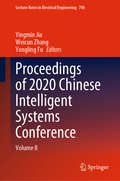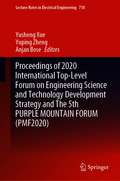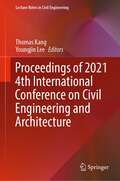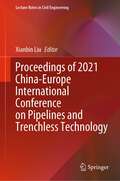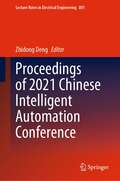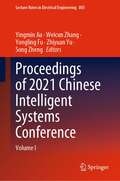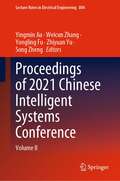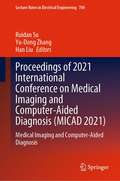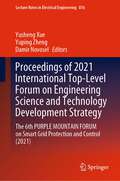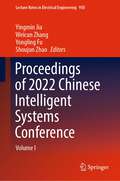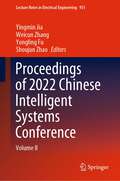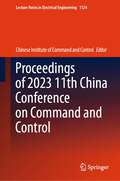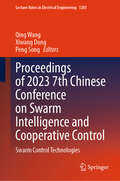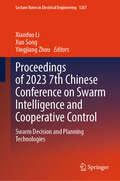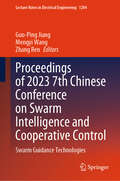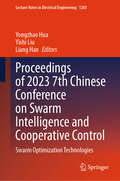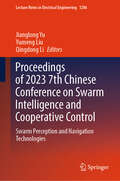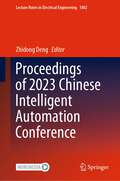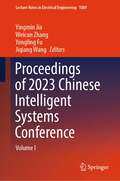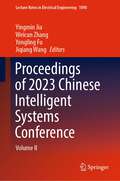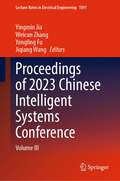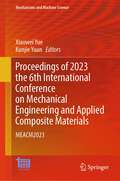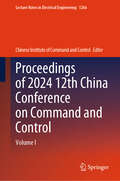- Table View
- List View
Proceedings of 2020 Chinese Intelligent Systems Conference: Volume II (Lecture Notes in Electrical Engineering #706)
by Yingmin Jia Weicun Zhang Yongling FuThe book focuses on new theoretical results and techniques in the field of intelligent systems and control. It provides in-depth studies on a number of major topics such as Multi-Agent Systems, Complex Networks, Intelligent Robots, Complex System Theory and Swarm Behavior, Event-Triggered Control and Data-Driven Control, Robust and Adaptive Control, Big Data and Brain Science, Process Control, Intelligent Sensor and Detection Technology, Deep learning and Learning Control Guidance, Navigation and Control of Flight Vehicles and so on. Given its scope, the book will benefit all researchers, engineers, and graduate students who want to learn about cutting-edge advances in intelligent systems, intelligent control, and artificial intelligence.
Proceedings of 2020 International Top-Level Forum on Engineering Science and Technology Development Strategy and The 5th PURPLE MOUNTAIN FORUM (Lecture Notes in Electrical Engineering #718)
by Yusheng Xue Yuping Zheng Anjan BoseThis book includes original, peer-reviewed research papers from the 2020 International Top-Level Forum on Engineering Science and Technology Development Strategy -- the 5th PURPLE MOUNTAIN FORUM on Smart Grid Protection and Control(PMF2020), held in Nanjing, China, on August 15-16, 2020. Hot topics and cutting edge technologies are included: - Advanced Power Transmission Technology - AC-DC Hybrid Power Grid Technology - eIoT Technology and Application - Operation, Protection and Control of Power Systems Supplied with High Penetration of Renewable Energy Sources - Active Distribution Network Technology - Smart Power Consumption and Energy-saving Technology - New Technology on Substation Automation - Clean Energy Technology - Energy Storage Technology and Application - Key Technology and Application of Integrated Energy - Application of AI, Block Chain, Big Data and Other New Technologies in Energy Industry - Application of New Information and Communication Technology in Energy Industry - Application of Technical Standard System and Related Research in Energy Industry The papers included in this proceeding share the latest research results and practical application examples on the methodologies and algorithms in these areas, which makes the book a valuable reference for researchers, engineers, and university students.
Proceedings of 2021 4th International Conference on Civil Engineering and Architecture (Lecture Notes in Civil Engineering #201)
by Thomas Kang Youngjin LeeThis book states that the proceedings gathers selected papers from 2021 4th International Conference on Civil Engineering and Architecture (ICCEA 2021), which was taken place in Seoul, South Korea, during July 10-12, 2021. The conference is the premier forum for the presentation of new advances and research results in the fields of theoretical, experimental, and practical civil engineering and architecture. And this proceedings from the conference mainly discusses architectural design and project management, environmental protection and spatial planning, design and analysis of building materials, and structural engineering and safety. And these materials can be useful and valuable sources for researchers and professionals working in the field of civil engineering and architecture.
Proceedings of 2021 China-Europe International Conference on Pipelines and Trenchless Technology (Lecture Notes in Civil Engineering #212)
by Xianbin LiuThis book is a compilation of selected papers from the 2021 China-Europe International Conference on Pipelines and Trenchless Technology. The international academic conference is organized to• further promote the cause of trenchless works in China• ensure the quality of engineering construction• introduce advanced technology, equipment, and materials• promote the exchange and learning of trenchless technology• enhance the level of trenchless technology in China• improve the international influence of trenchless academics in China• promote the standardization and localization of trenchless technology in China • and lead the healthy development of the industry..
Proceedings of 2021 Chinese Intelligent Automation Conference (Lecture Notes in Electrical Engineering #801)
by Zhidong DengThe proceedings present selected research papers from the CIAC2021, held in Zhanjiang, China on Nov 5-7, 2021. It covers a wide range of topics including intelligent control, robotics, artificial intelligence, pattern recognition, unmanned systems, IoT and machine learning. It includes original research and the latest advances in the field of intelligent automation. Engineers and researchers from academia, industry, and government can gain valuable insights into solutions combining ideas from multiple disciplines in this field.
Proceedings of 2021 Chinese Intelligent Systems Conference: Volume I (Lecture Notes in Electrical Engineering #803)
by Yingmin Jia Weicun Zhang Yongling Fu Zhiyuan Yu Song ZhengThis book presents the proceedings of the 17th Chinese Intelligent Systems Conference, held in Fuzhou, China, on Oct 16-17, 2021. It focuses on new theoretical results and techniques in the field of intelligent systems and control. This is achieved by providing in-depth study on a number of major topics such as Multi-Agent Systems, Complex Networks, Intelligent Robots, Complex System Theory and Swarm Behavior, Event-Triggered Control and Data-Driven Control, Robust and Adaptive Control, Big Data and Brain Science, Process Control, Intelligent Sensor and Detection Technology, Deep learning and Learning Control Guidance, Navigation and Control of Flight Vehicles and so on. The book is particularly suited for readers who are interested in learning intelligent system and control and artificial intelligence. The book can benefit researchers, engineers, and graduate students.
Proceedings of 2021 Chinese Intelligent Systems Conference: Volume II (Lecture Notes in Electrical Engineering #804)
by Yingmin Jia Weicun Zhang Yongling Fu Zhiyuan Yu Song ZhengThis book presents the proceedings of the 17th Chinese Intelligent Systems Conference, held in Fuzhou, China, on Oct 16-17, 2021. It focuses on new theoretical results and techniques in the field of intelligent systems and control. This is achieved by providing in-depth study on a number of major topics such as Multi-Agent Systems, Complex Networks, Intelligent Robots, Complex System Theory and Swarm Behavior, Event-Triggered Control and Data-Driven Control, Robust and Adaptive Control, Big Data and Brain Science, Process Control, Intelligent Sensor and Detection Technology, Deep learning and Learning Control Guidance, Navigation and Control of Flight Vehicles and so on. The book is particularly suited for readers who are interested in learning intelligent system and control and artificial intelligence. The book can benefit researchers, engineers, and graduate students.
Proceedings of 2021 International Conference on Medical Imaging and Computer-Aided Diagnosis: Medical Imaging and Computer-Aided Diagnosis (Lecture Notes in Electrical Engineering #784)
by Han Liu Yu-Dong Zhang Ruidan SuThis book covers virtually all aspects of image formation in medical imaging, including systems based on ionizing radiation (x-rays, gamma rays) and non-ionizing techniques (ultrasound, optical, thermal, magnetic resonance, and magnetic particle imaging) alike. In addition, it discusses the development and application of computer-aided detection and diagnosis (CAD) systems in medical imaging. Also there will be a special track on computer-aided diagnosis on COVID-19 by CT and X-rays images. Given its coverage, the book provides both a forum and valuable resource for researchers involved in image formation, experimental methods, image performance, segmentation, pattern recognition, feature extraction, classifier design, machine learning / deep learning, radiomics, CAD workstation design, human–computer interaction, databases, and performance evaluation.
Proceedings of 2021 International Top-Level Forum on Engineering Science and Technology Development Strategy: The 6th PURPLE MOUNTAIN FORUM on Smart Grid Protection and Control (2021) (Lecture Notes in Electrical Engineering #816)
by Yusheng Xue Yuping Zheng Damir NovoselThis book includes original, peer-reviewed research papers from the 2021 International Top-Level Forum on Engineering Science and Technology Development Strategy -- the 6th PURPLE MOUNTAIN FORUM on Smart Grid Protection and Control (PMF2021), held in Nanjing, China, on August 14-22, 2021. The accepted papers cover the following topics: 1. Advanced power transmission technology2. AC/DC hybrid power grid technology3. Power Internet of Things Technology and Application4. Operation, control and protection of smart grid5. Active distribution network technology6. Power electronic technology and application7. New technology of substation automation8. Energy storage technology and application9. Application of new technologies such as artificial intelligence, blockchain, and big data10. Application of Information and Communication Technology11. Low-carbon energy planning and security12. Low-carbon operation of the power system13. Low-carbon energy comprehensive utilization technology14. Carbon trading and power market15. Carbon emission stream and carbon capture technology16. Energy saving and smart energy technology17. Analysis and evaluation of low-carbon efficiency of power system18. Carbon flow modelling in power system operationThe papers included in this proceeding share the latest research results and practical application examples on the methodologies and algorithms in these areas, which makes the book a valuable reference for researchers, engineers, and university students.
Proceedings of 2022 10th China Conference on Command and Control (Lecture Notes in Electrical Engineering #949)
by Chinese Institute of Command and ControlThis book includes original, peer-reviewed research papers from the 2022 10th China Conference on Command and Control (C2 2022), held in Beijing, China on July 7-9, 2022. The topics covered include but are not limited to: Theories, Modelling and Simulation, System Engineering Technology for Intelligent Command and Control, 5G and Intelligent Command, Control and Management Integration Technology, Joint Cooperative Command and Control Organization Management, Agility in the Network Age, Cyberspace Situational Awareness Technology, CPS Parallel Management and Control、Unmanned Systems, Intelligent Military Camp Technology, Architecture Design for Intelligent Air Traffic Control System, Human-Machine Interaction and Virtual Reality, Swarm Intelligence and Cooperative Control, Intelligent Gaming Theory and Technology.The papers showcased here share the latest findings on theories, algorithms and applications in command and control, making the book a valuable asset for researchers, engineers, and university students alike.
Proceedings of 2022 4th International Conference on Environment Sciences and Renewable Energy: Selected Topics on New Developments in Environmental and Energy Technologies (Environmental Science and Engineering)
by Raf Dewil Jan Baeyens Barbara Rossi Yimin DengThis book consists of selected papers from the 2022 4th International Conference on Environment Sciences and Renewable Energy, which was held as a fully virtual conference during May 27–29, 2022. The book overviews the latest progress in environmental and energy technologies with a specific focus on wind turbines and hydrogen production. In the field of environmental science, wastewater treatment, air pollution abatement, solid waste treatment, and general policy recommendations are discussed. Technology advances, especially in wastewater nutrients and micropollutant removal, are covered. In policy measures, cost allocations, optimum recycling strategies, and environmental footprint allocations of different environmental technologies are included. In the field of renewable energy, several hot topics, including solar cells, offshore floating wind turbines, and renewable energy resource potentials in different regions are considered.
Proceedings of 2022 Chinese Intelligent Systems Conference: Volume I (Lecture Notes in Electrical Engineering #950)
by Yingmin Jia Weicun Zhang Yongling Fu Shoujun ZhaoThis book constitutes the proceedings of the 18th Chinese Intelligent Systems Conference, CISC 2022, which was held during October 15–16, 2022, in Beijing, China.The papers in these proceedings deal with various topics in the field of intelligent systems and control, such as multi-agent systems, complex networks, intelligent robots, complex system theory and swarm behavior, event-triggered control and data-driven control, robust and adaptive control, big data and brain science, process control, intelligent sensor and detection technology, deep learning and learning control guidance, navigation and control of aerial vehicles.
Proceedings of 2022 Chinese Intelligent Systems Conference: Volume II (Lecture Notes in Electrical Engineering #951)
by Yingmin Jia Weicun Zhang Yongling Fu Shoujun ZhaoThis book constitutes the proceedings of the 18th Chinese Intelligent Systems Conference, CISC 2022, which was held during October 15–16, 2022, in Beijing, China.The 178 papers in these proceedings were carefully reviewed and selected from 185 submissions. The papers deal with various topics in the field of intelligent systems and control, such as multi-agent systems, complex networks, intelligent robots, complex system theory and swarm behavior, event-triggered control and data-driven control, robust and adaptive control, big data and brain science, process control, intelligent sensor and detection technology, deep learning and learning control guidance, navigation and control of aerial vehicles.
Proceedings of 2023 11th China Conference on Command and Control (Lecture Notes in Electrical Engineering #1124)
by Chinese Institute of Command and ControlThis book presents a selection of peer-reviewed research papers that were originally presented at the 11th China Conference on Command and Control (C2 2023), held in Beijing, China, on October 24–25, 2023. The book covers a wide range of topics related to intelligent command and control, including Theories, Modeling and Simulation, System Engineering Technology, 5G and Intelligent Command, Control and Management Integration Technology, Joint Cooperative Command and Control Organization Management, Agility in the Network Age, Cyberspace Situational Awareness Technology, CPS Parallel Management and Control, Unmanned Systems, Intelligent Military Camp Technology, Architecture Design for Intelligent Air Traffic Control Systems, Human–Machine Interaction and Virtual Reality, Swarm Intelligence and Cooperative Control, and Intelligent Gaming Theory and Technology. The research presented in this book offers the latest insights into theories, algorithms, and applications in command and control. As such, it is an essential resource for researchers, engineers, and university students interested in this field. By bringing together cutting-edge research from leading scholars in the field, this book provides a comprehensive overview of the latest advances in command and control, making it a valuable asset for anyone seeking to deepen their understanding of this important subject.
Proceedings of 2023 7th Chinese Conference on Swarm Intelligence and Cooperative Control: Swarm Control Technologies (Lecture Notes in Electrical Engineering #1205)
by Qing Wang Xiwang Dong Peng SongThis book includes original, peer-reviewed research papers from the 2023 7th Chinese Conference on Swarm Intelligence and Cooperative Control (CCSICC2023), held in Nanjing, China on November 17-19, 2023. The topics covered include but are not limited to: reviews and discussions of swarm intelligence, basic theories on swarm intelligence, swarm communication and networking, swarm perception, awareness and location, swarm decision and planning, cooperative control, cooperative guidance, swarm simulation and assessment. The papers showcased here share the latest findings on theories, algorithms and applications in swarm intelligence and cooperative control, making the book a valuable asset for researchers, engineers, and university students alike.
Proceedings of 2023 7th Chinese Conference on Swarm Intelligence and Cooperative Control: Swarm Decision and Planning Technologies (Lecture Notes in Electrical Engineering #1207)
by Xiaoduo Li Xun Song Yingjiang ZhouThis book includes original, peer-reviewed research papers from the 2023 7th Chinese Conference on Swarm Intelligence and Cooperative Control (CCSICC2023), held in Nanjing, China on November 17-19, 2023. The topics covered include but are not limited to: reviews and discussions of swarm intelligence, basic theories on swarm intelligence, swarm communication and networking, swarm perception, awareness and location, swarm decision and planning, cooperative control, cooperative guidance, swarm simulation and assessment. The papers showcased here share the latest findings on theories, algorithms and applications in swarm intelligence and cooperative control, making the book a valuable asset for researchers, engineers, and university students alike.
Proceedings of 2023 7th Chinese Conference on Swarm Intelligence and Cooperative Control: Swarm Guidance Technologies (Lecture Notes in Electrical Engineering #1204)
by Zhang Ren Guo-Ping Jiang Mengyi WangThis book includes original, peer-reviewed research papers from the 2023 7th Chinese Conference on Swarm Intelligence and Cooperative Control (CCSICC2023), held in Nanjing, China on November 17-19, 2023. The topics covered include but are not limited to: reviews and discussions of swarm intelligence, basic theories on swarm intelligence, swarm communication and networking, swarm perception, awareness and location, swarm decision and planning, cooperative control, cooperative guidance, swarm simulation and assessment. The papers showcased here share the latest findings on theories, algorithms and applications in swarm intelligence and cooperative control, making the book a valuable asset for researchers, engineers, and university students alike.
Proceedings of 2023 7th Chinese Conference on Swarm Intelligence and Cooperative Control: Swarm Optimization Technologies (Lecture Notes in Electrical Engineering #1203)
by Liang Han Yongzhao Hua Yishi LiuThis book includes original, peer-reviewed research papers from the 2023 7th Chinese Conference on Swarm Intelligence and Cooperative Control (CCSICC2023), held in Nanjing, China on November 17-19, 2023. The topics covered include but are not limited to: reviews and discussions of swarm intelligence, basic theories on swarm intelligence, swarm communication and networking, swarm perception, awareness and location, swarm decision and planning, cooperative control, cooperative guidance, swarm simulation and assessment. The papers showcased here share the latest findings on theories, algorithms and applications in swarm intelligence and cooperative control, making the book a valuable asset for researchers, engineers, and university students alike.
Proceedings of 2023 7th Chinese Conference on Swarm Intelligence and Cooperative Control: Swarm Perception and Navigation Technologies (Lecture Notes in Electrical Engineering #1206)
by Jianglong Yu Yumeng Liu Qingdong LiThis book includes original, peer-reviewed research papers from the 2023 7th Chinese Conference on Swarm Intelligence and Cooperative Control (CCSICC2023), held in Nanjing, China on November 17-19, 2023. The topics covered include but are not limited to: reviews and discussions of swarm intelligence, basic theories on swarm intelligence, swarm communication and networking, swarm perception, awareness and location, swarm decision and planning, cooperative control, cooperative guidance, swarm simulation and assessment. The papers showcased here share the latest findings on theories, algorithms and applications in swarm intelligence and cooperative control, making the book a valuable asset for researchers, engineers, and university students alike.
Proceedings of 2023 Chinese Intelligent Automation Conference (Lecture Notes in Electrical Engineering #1082)
by Zhidong DengThe book presents selected research papers from the 2023 Chinese Intelligent Automation Conference (CIAC2023), held in Nanjing, China, on October 2-5, 2023. It covers a wide range of topics including intelligent control, robotics, artificial intelligence, pattern recognition, unmanned systems, IoT, and machine learning. It includes original research and the latest advances in the field of intelligent automation. Engineers and researchers from academia, industry, and government can gain valuable insights into solutions combining ideas from multiple disciplines in this field.
Proceedings of 2023 Chinese Intelligent Systems Conference: Volume I (Lecture Notes in Electrical Engineering #1089)
by Yingmin Jia Weicun Zhang Yongling Fu Jiqiang WangThis book constitutes the proceedings of the 19th Chinese Intelligent Systems Conference, CISC 2023, which was held during October 14–15, 2023, in Ningbo, Zhejiang, China. The book focuses on new theoretical results and techniques in the field of intelligent systems and control. This is achieved by providing in-depth studies of a number of important topics such as multi-agent systems, complex networks, intelligent robots, complex systems theory and swarm behavior, event-driven and data-driven control, robust and adaptive control, big data and brain science, process control, intelligent sensors and detection technology, deep learning and learning control, navigation and control of aerial vehicles, and so on. The book is particularly suitable for readers interested in learning intelligent systems and control and artificial intelligence. The book can benefit researchers, engineers and graduate students.
Proceedings of 2023 Chinese Intelligent Systems Conference: Volume II (Lecture Notes in Electrical Engineering #1090)
by Yingmin Jia Weicun Zhang Yongling Fu Jiqiang WangThis book constitutes the proceedings of the 19th Chinese Intelligent Systems Conference, CISC 2023, which was held during October 14–15, 2023, in Ningbo, Zhejiang, China. The book focuses on new theoretical results and techniques in the field of intelligent systems and control. This is achieved by providing in-depth studies of a number of important topics such as multi-agent systems, complex networks, intelligent robots, complex systems theory and swarm behavior, event-driven and data-driven control, robust and adaptive control, big data and brain science, process control, intelligent sensors and detection technology, deep learning and learning control, navigation and control of aerial vehicles, and so on. The book is particularly suitable for readers interested in learning intelligent systems and control and artificial intelligence. The book can benefit researchers, engineers and graduate students.
Proceedings of 2023 Chinese Intelligent Systems Conference: Volume III (Lecture Notes in Electrical Engineering #1091)
by Yingmin Jia Weicun Zhang Yongling Fu Jiqiang WangThis book constitutes the proceedings of the 19th Chinese Intelligent Systems Conference, CISC 2023, which was held during October 14–15, 2023, in Ningbo, Zhejiang, China. The book focuses on new theoretical results and techniques in the field of intelligent systems and control. This is achieved by providing in-depth studies of a number of important topics such as multi-agent systems, complex networks, intelligent robots, complex systems theory and swarm behavior, event-driven and data-driven control, robust and adaptive control, big data and brain science, process control, intelligent sensors and detection technology, deep learning and learning control, navigation and control of aerial vehicles, and so on. The book is particularly suitable for readers interested in learning intelligent systems and control and artificial intelligence. The book can benefit researchers, engineers and graduate students.
Proceedings of 2023 the 6th International Conference on Mechanical Engineering and Applied Composite Materials: MEACM2023 (Mechanisms and Machine Science #156)
by Xiaowei Yue Kunjie YuanThis book focuses on selected aspects of the current and upcoming trends in mechanical engineering and applied composite materials. In detail, the included scientific papers present the study of applied composite materials to advance the research and application of mechanical behaviors, manufacturing techniques, and structural applications. These cutting-edge research papers help in developing innovative composite solutions, and address challenges in industries such as aerospace, automotive, and civil engineering. The collaboration between mechanical engineering and applied composite materials in the research leads to advancements in material science, manufacturing methods, and structural design principles. This book is the documentation of the 6th International Conference on Mechanical Engineering and Applied Composite Materials (MEACM2023), which took place in Sanya, China, on December 28-29, 2023.
Proceedings of 2024 12th China Conference on Command and Control: Volume I (Lecture Notes in Electrical Engineering #1266)
by Chinese Institute of Command and ControlThis book contains the original, peer-reviewed research papers presented at the 12th China Conference on Command and Control (C2 CHINA 2024) held in Beijing, China on 17-18 May 2024. Topics covered include but are not limited to Theory, Method and Technique of Military Command; Multi-domain Command and Control; Counter-terrorism Special Operations Command and Control; Smart City and Social Governance; Logistics and Equipment Support; Smart Barracks System Management; Intelligent Air Traffic Control and Integrated Transportation; Intelligent Logistics and Supply Chain Management; Security Protection and Emergency Management; Multi-domain Situational Awareness and Cognition; Information Fusion Theory and Technology; Cognitive and Behavioural Theory Techniques; Cyberspace Situational Awareness and Mapping; Planning, Decision Theory and Technology; Cognitive Game, Intelligent Game Theory and Technology; Unmanned Systems Command and Control; Cluster Intelligence and Cooperative Control; Intelligent Command and Dispatch System and Technology; Cloud Control, Active Disturbance Rejection Control Theory and Technology; Complex System Reliability, Toughness, Robustness; Communication, Navigation and Guidance Technology in Command and Control; Data Link Theory and Technology; Cyberspace Security Theory and Technology; Space Information System and Satellite Resource Management; Satellite Internet Communication, Navigation and Remote Sensing Integration and Security Technology; Intelligent Internet of Things Technology; Electromagnetic Spectrum Security and Control; Artificial Intelligence - Machine Learning, GPT Technology; Virtual Reality, Human-Computer Interaction and Intelligent Wearable Technology; Big Data, Big Model Theory and Technology; Meta-Universes, Digital Twins and Parallel Systems; Blockchain Technology. The papers presented here share the latest findings on theories, algorithms and applications in command and control, making the book a valuable resource for researchers, engineers and students alike.
